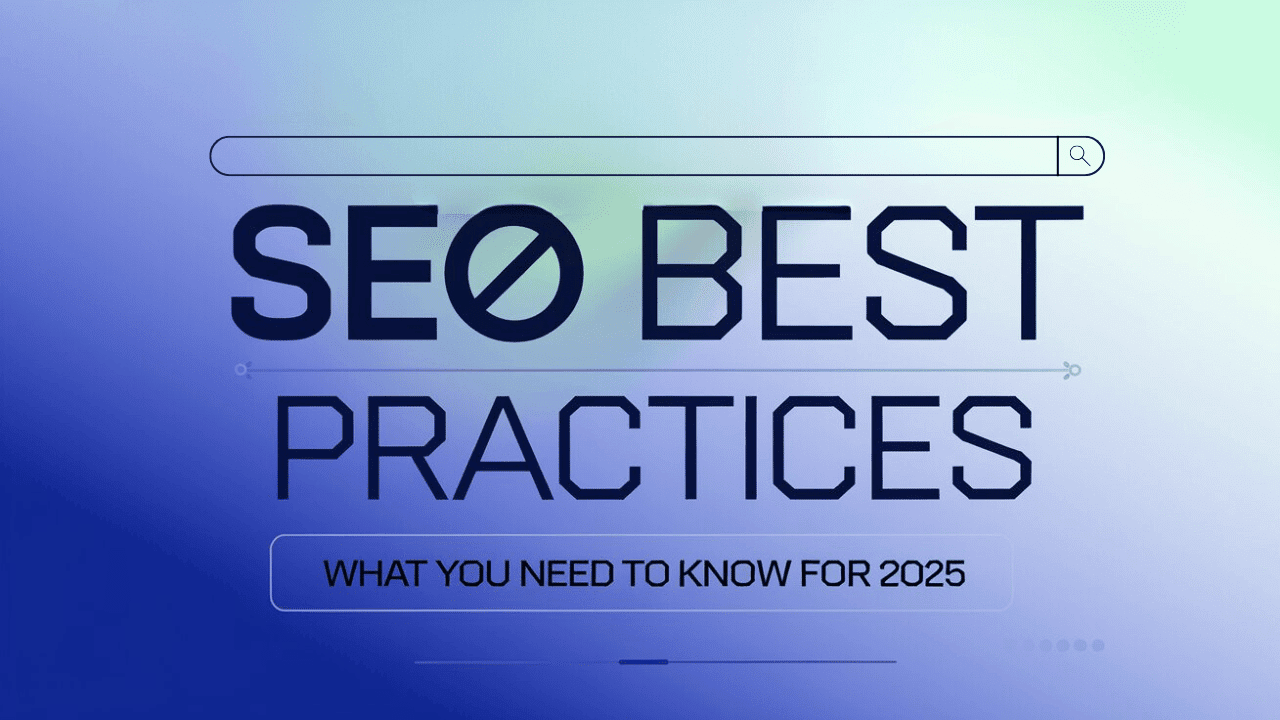It is now important to understand that SEO has never been a sort of approach that requires you to set it and forget it. It is a dynamic area where change occurs due to developments made by search engines or updates as a result of advancing technologies or altered user behaviors or more rigid content quality requirements. With the focus on 2025, several priorities become apparent; user experience, cultivating relationships with content and creating stronger systems and foundations for websites. Let us examine the most effective approach and Effective Best SEO Practices that has to be taken to meet the current day SEO challenge and to prepare for tomorrow’s challenge.
The Shift to User-Focused SEO

In The SEO Best Practices, It is evident that in 2025, with the continued push towards user-oriented approaches, having a focus strictly on SEO requirements is no longer a possibility. As we have seen, different search engines have especially focused on the user intent while searching for something on the internet leading to a more enhanced or personalized search results. Other websites that are able to focus on such user Centred SEO techniques will benefit from better rankings, higher level of engagement and higher visibility.
Understanding Search Intent and Context
Search intent is not just about knowing what user want but also taking time to figure out why they want it. Explicitly, all Google algorithms are aimed at identifying these underlying causes and present results that best meet the user’s needs. For example, a user searching a “best laptops for students” is probably looking for comparing models according to price/quality ratio. If your content does not meet those considerations then your site has no possibility of ranking.
Knowledge of the search intent lets you target the exact need of your audience and meet it across the spectrum, becoming that one-stop solution. This means learning about the different intents that users may have, including informational, navigational, transactional or commercial and then structuring content in a way that answers those intents best.
Prioritizing Accessibility and Readability
One of the most important but least addressed aspects of SEO is ‘Accessibility’; how accessible and easily readable your site is to any user let alone a disabled one. When the year is 2025, Google still encourages sites to remain accessible for users and it is not just because it is the right thing to do, but it is a thing that will enhance experience for all users.
It’s just simply making sure the material is clear in its wording, using fundamental text size, and including text descriptions for visuals. Moreover, simplicity maintains the audience. For friends. If they can decipher your articles with ease, they are likely going to spend more time on your site, which is always good for SEO rankings.
Building Trust Through Transparency
Transparency has now shifted to the importance of the online community. Web users are now more particular about which sites they patronize regularly because of issues on privacy et cetera. It makes trust when people have clear and easily accessed information about your business, policies and authorship.
For example adding author bio which demonstrates that real people are behind the provided content and adding a separate ‘Contact Us’ page which increases credibility. Even websites which dedicate efforts to gain the users’ trust, have advantages including the traffic. Search engines pay attention to this interaction and increase the rankings as they find your site to be a worthwhile, reliable reference.
The Role of Mobile and Voice search

In SEO Best Practices, One thing significant about the way that people search has changed over time is technology. In particular the mobile devices and the voice-activated assistants have altered the SEO practices. Users require immediate results that are related to their current situation and that can be provided using the portable technology. Mobile and voice search has not only becoming another feature of SEO, but it is becoming unavoidable in this competitive search space.
Optimizing for Conversational Keywords
Voice search, therefore, is a conversational search and not a keyword search. Users address the speech-based AI like a fellow human being and as such the user may use full commands or questions when interacting with the assistant. It really does go a long way to simply tweak a SEO campaign to fit the conversational keywords. It involves seeking out those longer phrase-style questions rather than sticking to short tail, broad terms.
For example, instead of having the base keyword as “healthy recipes” try having the base keyword as “best recipes for a healthy dinner.” By answering these questions, you increase the chances of your content being suitable for voice search and expand your user base of your site.
Mobile-First Indexing and Responsiveness
Mobile response as main index means, that for the search engines main attention will be paid to the mobile version of your site. It means that if your site has not adopted to the mobile versions, then your site will not rank high. According to this requirement, the important aspect to consider is the responsive design that enables your site to adapt to the various devices.
A responsive site help to optimize the website with proper navigation, readability, and accessibility of any device. Slowing down the page load time and customizing content for small screens are also important here. When users can easily reach your site on mobile, it retains user interest, optimizes time spent on your site and minimizes bounce rates, landmarks to search ranking.
Local Search Adaptations
With the introduction of voice search comes more focus on local keywords, mainly when people are searching for services or merchants. This is due to the fact that local SEO is very important particularly to any business that is local and seeking to attract local clientele. Local listing factors involve endowing the company’s Google My Business with proper information, gleaning reviews, and making content focusing on local users.
Including local keywords which may include the names of cities, town, or any word that users type-in when searching for products ‘near me’ makes the business appear on the local search results which in return increases visibility to users searching nearby.
Content That Engages and Informs

Form The SEO Best Practices In 2025, the content rules, but not everything that is created can be considered good content. This is on ensuring that the content out put has quality, relativity, interest and information that keeps a reader fixated. The content which is interesting to the users has better sharing frequency as well as a better rank due to the positivity of the users’ signals.
Storytelling and Relatable Content
Today’s readers follow only content that is interesting, or represents them in some way, in a narrated manner. Storytelling enables you to weave links which makes the content you are delivering relevant and meaningful. Ideas that are usually close to people’s experience or concern that targets a certain segment of the audience usually works best. Elements include, users tend to spend more time on the content, engage with content, and share it. When you incorporate storytelling feature into your material, they are likely to come back and also associate with your brand.
Updating and Repurposing Content
What was interesting about the SEO techniques discussed is that it is not only about developing new content, but also about refreshing existing content. Further, the strategy of updating a particular post, for example, with recent data or integrating new information to the material can help not only to remain at the properly chosen position but even to ‘move up’ the scale.
Moreover, it is useful to repost what surprised your audience positively. for example, turning successful posts into a video, infographic, or podcast. Repurposed content takes advantage of diverse audiences, ensuring that through video or audio, your brand reaches out to people who might not have read your blog.
Visual Content Optimization
Since search engines are smarter and can analyze any other features beside text, images and videos are important to SEO. Making these visuals better by adding alt text, compressing them to increase loading speed, and including tags guarantees that they yield a positive result on your ranking.
That is why such multimedia formats as videos can positively influence the level of users’ engagement with content that directly affects SEO. Users are more likely to stay on a page longer when there’s engaging visual content, which tells search engines that your site offers valuable, enjoyable experiences.
The Technical Side of SEO

In The SEO Best Practices, Technical SEO is an aspect of search engine optimization that must be at the core of any performing website. Moving from optimising speed to structured data category, all the technicalities make your site to be as efficient as possible to offer its users a trouble free interface. Technical optimization in 2025 means using security, speed and structure to improve website and make the user’s experience much more positive.
Enhancing Page Load Speed
The first thing that web developers need to accept is that a slow-loading website will not be able to keep visitors on the site. Anything that takes several seconds, or even a single second, to load causes users to leave the site, augmenting bounce rates.
The solution to make page loading faster include optimizing images and using caching along with minimizing codes. But when you work on speed, then you are not only following UX best practices, you are also working towards improved SEO. Not only is a fast site great for engagement it is also a sign to the search engines that your site is a quality site.
Structured Data and Rich Snippets
Inserts microdata, or schema markup, improve search engines’ ability to comprehend the content of your website. Structured data allows the search engines to display more information in the SERPs such as star ratings for a particular product, or other details about an event.
Rich snippets help drive clicks because they make your listing pop. Structured data also improves voice search optimization since; the organized formats can easily be understandable to search engines and are friendly to the user in all devices.
Strengthening Security Measures
Security can be important to technical SEO among all things. Customers trust sites that are secure and this is well understood by the search engines and they give those sites better rankings. To guaranteeing HTTPS encryption, to safeguarding user data, it makes sense to pay attention to security since it fosters users’ trust.
A well secured site garners more traffic cutting down on instances of cyber menace and increasing site legitimacy. When people feel secured, or comfortable using your website, this will also increase chances of repeat use of the site, improving engagement and relevant search rankings.
Summary
As we move into a new year, SEO remains a primary focus with increasing attention to user-focused processes, quality content, and technology. This all boils down to knowing your audience interest, the mobile and voice search, keyword and topic creation, as well as designing a structurally proficient website. These ways do not only enhance SEO optimization but also provide better and more interesting experience for visitors. Keep metamorphosing and focusing on creating value, and you’ll be fine for the future of SEO.

